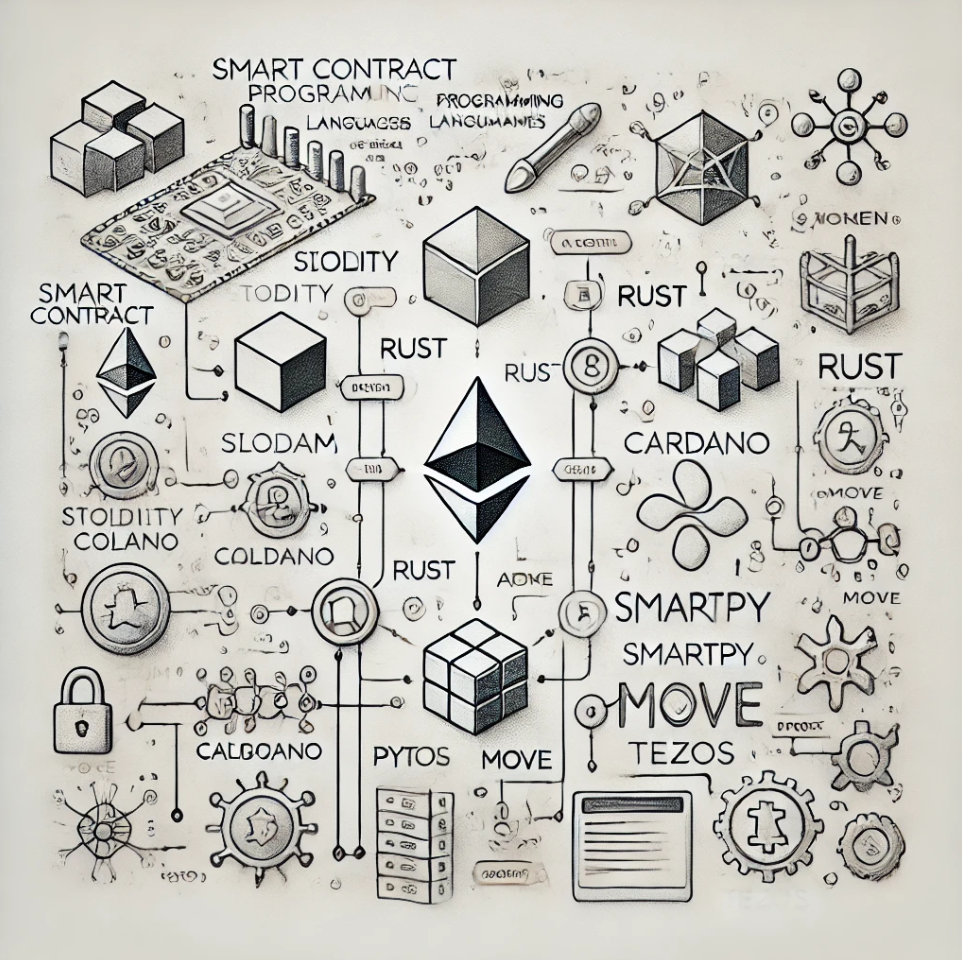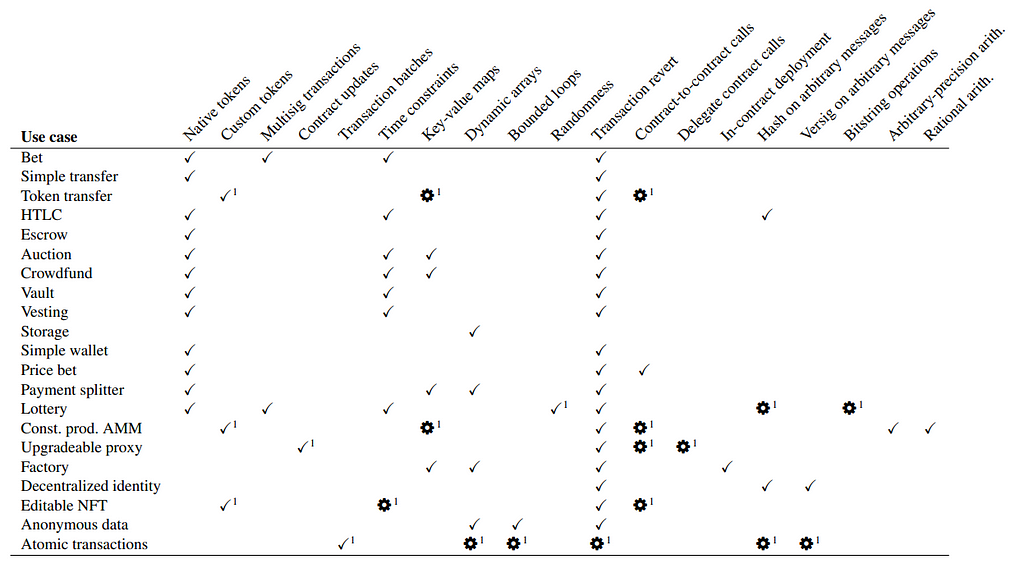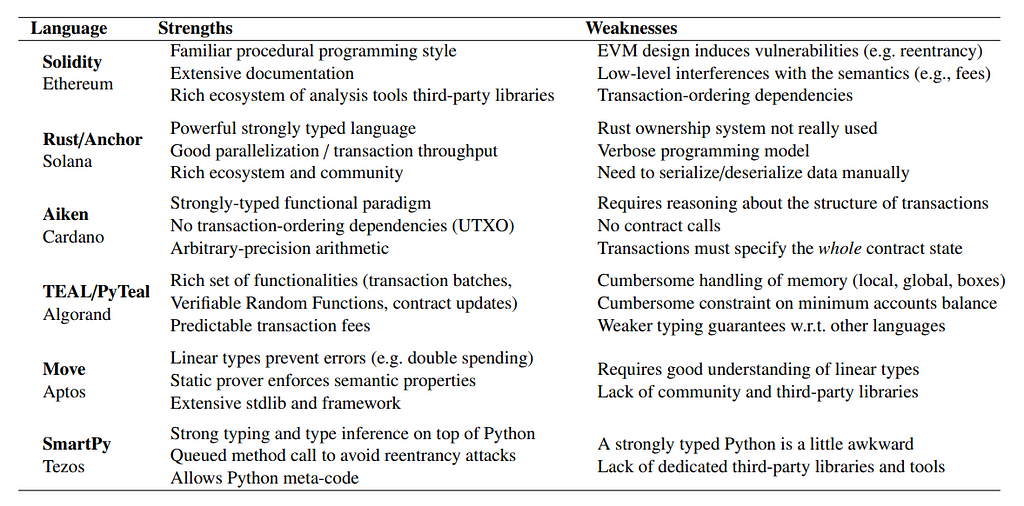and the distribution of digital products.
DM Television
Which Smart Contract Language Is Best for Blockchain Development in 2024?
Looking for the best smart contract language for blockchain development in 2024? A new study compares Solidity, Rust, Aiken, PyTeal, Move, and SmartPy to help you make the right choice.
 Blockchain Comparison. Image created using DALL-E.
Blockchain Comparison. Image created using DALL-E.Smart contracts, the building blocks of decentralized applications, are transforming how we conduct business on the blockchain by automating processes and eliminating intermediaries.However, with multiple programming languages available, developers face the challenge of selecting the right tool for their needs. The research paper titled “Smart Contract Languages: A Comparative Analysis” (Bartoletti et al., 2024) delves into this conundrum by assessing six prominent smart contract languages: Solidity (Ethereum), Rust (Solana), Aiken (Cardano), PyTeal (Algorand), Move (Aptos), and SmartPy (Tezos). Through an original benchmark of use cases, the paper evaluates their usability, security, and performance, offering insights into their design and implications for developers.
Summary of the Research ArticleThe paper seeks to answer the question: how do different smart contract languages perform under similar conditions? To investigate this, the authors developed the “Rosetta Smart Contracts” benchmark, a set of use cases that cut across various real-world DApp scenarios, ranging from auctions to atomic transactions. This approach thoroughly compares programming styles, readability, verbosity, and security. The study focuses primarily on permissionless blockchain platforms, noting that permissioned blockchains generally use general-purpose languages, which are less relevant to the study’s goals.
The methodology compares six languages, each tied to its respective blockchain platform:
- Solidity for Ethereum, the most widely used, adopts a procedural style with an account-based model.
- Rust on Solana offers a highly parallelization system but requires complex manual data handling.
- Aiken, a functional language for Cardano, works within the UTXO model, emphasizing security but proving cumbersome for state management.
- PyTeal on Algorand, combining procedural and approval styles, is unique for its memory management and transaction batching.
- Move on Aptos uses linear types to avoid errors like double spending, while SmartPy on Tezos builds on Python’s meta-programming but struggles with third-party library support.
 Figure 1. The table presents details of various smart contract platforms, outlining their accounting models, contract storage methods, fee structures, main programming languages, and programming styles. Platforms include Ethereum, Solana, Cardano, Aptos, Algorand, and Tezos. Source: Smart Contract Languages: a comparative analysis, pg. 10.
Figure 1. The table presents details of various smart contract platforms, outlining their accounting models, contract storage methods, fee structures, main programming languages, and programming styles. Platforms include Ethereum, Solana, Cardano, Aptos, Algorand, and Tezos. Source: Smart Contract Languages: a comparative analysis, pg. 10.The analysis draws on the hands-on implementation of 21 use cases, such as multi-signature transactions, vesting contracts, and payment splitters, comparing how each language supports key features like contract-to-contract calls, reverts, and randomness. Additionally, the authors assess the tooling available for each language, including compilers, analyzers, and testing environments, critical for ensuring code security.
Critical AnalysisOne of the paper’s key strengths is its holistic benchmarking approach, which goes beyond mere theoretical analysis. By implementing use cases across multiple platforms, the authors provide a practical, real-world comparison that highlights not just the capabilities of each language but also their limitations. For example, Solidity’s reliance on low-level constructs introduces potential vulnerabilities, such as reentrancy attacks, while PyTeal’s strict constraints on account balances make it challenging to manage complex contract logic.
 Figure 2. The table presents a detailed comparison of smart contract use cases like betting, auctions, and token transfers, highlighting required functionalities such as native tokens, multi-signature transactions, and contract-to-contract calls. It uses checkmarks for natively supported features and gears to denote workarounds that can be implemented when native support is unavailable. Source: Smart Contract Languages: a comparative analysis, pg. 10.
Figure 2. The table presents a detailed comparison of smart contract use cases like betting, auctions, and token transfers, highlighting required functionalities such as native tokens, multi-signature transactions, and contract-to-contract calls. It uses checkmarks for natively supported features and gears to denote workarounds that can be implemented when native support is unavailable. Source: Smart Contract Languages: a comparative analysis, pg. 10.However, the paper’s focus on Turing-complete languages may limit its generalizability. By excluding non-Turing-complete options like Kadena’s Pact and Tezos’ Liquidity, the study overlooks languages that prioritize security by deliberately limiting functionality. Furthermore, the benchmark emphasizes technical features and security, but user experience — such as ease of learning and developer support — is only briefly touched upon. This is significant, as community support often determines a language’s adoption in real-world scenarios.
Despite these limitations, the paper’s comparative framework is invaluable, particularly its analysis of how contract languages manage transaction fees, off-chain interactions, and the crucial balance between security and usability. The unique contribution of the Rosetta Smart Contracts benchmark offers a replicable method for evaluating future languages and platforms, positioning the paper as a foundational work in the field.
Highlight: The Most Surprising AspectOne of the most surprising revelations in the paper is the divergence between the account-based model and the UTXO model (Unspent Transaction Output). While Ethereum’s account-based model dominates smart contract development due to Solidity’s popularity, Cardano’s UTXO model, as seen through Aiken, provides stronger security guarantees at the cost of greater complexity. This paradigm shifts from a procedural style, where the contract updates its state, to an approval style, where the contract only verifies transaction updates, fundamentally changing how developers approach smart contract logic.
The need to explicitly manage state transitions in the UTXO model can be cumbersome for developers more accustomed to procedural programming, yet it significantly reduces certain vulnerabilities, such as transaction ordering attacks, which are prevalent in account-based systems like Ethereum. The paper’s detailed comparison of these two models highlights how different foundational choices in blockchain architecture can ripple out into developer experience and contract security.
 The table provides an overview of key strengths and weaknesses for various smart contract languages across popular blockchain platforms, emphasizing characteristics such as security, usability, and performance, with Solidity, Rust, Aiken, PyTeal, Move, and SmartPy highlighted. Source: Smart Contract Languages: a comparative analysis, pg. 18.Implications and Potential
The table provides an overview of key strengths and weaknesses for various smart contract languages across popular blockchain platforms, emphasizing characteristics such as security, usability, and performance, with Solidity, Rust, Aiken, PyTeal, Move, and SmartPy highlighted. Source: Smart Contract Languages: a comparative analysis, pg. 18.Implications and PotentialThe findings from this comparative analysis have far-reaching implications for blockchain development and decentralized applications’ future. First, the study underscores the importance of security-focused design in smart contract languages. As vulnerabilities in Ethereum’s EVM (Ethereum Virtual Machine) have shown, poorly designed languages can expose DApps to catastrophic failures, particularly in handling assets and contract calls. Thus, the robust typing and transaction structures in languages like Aiken and Move may become more attractive as the blockchain ecosystem matures.
The research suggests that future smart contract languages could benefit from hybrid models, blending the ease of account-based models with the security advantages of UTXO-based approaches. Algorand’s PyTeal, for instance, represents a step in this direction, combining procedural elements with UTXO-like transaction management, allowing for greater flexibility while maintaining some security guarantees.
Another potential development area is tooling and developer support. Languages like Solidity, which enjoy extensive community support and mature tool ecosystems, are more likely to see continued adoption, despite their technical limitations. However, the rise of newer languages like Move and Aiken, with their advanced security features, could shift developer interest, especially if these languages build stronger communities and third-party libraries .
ConclusionThe comparative analysis of smart contract languages conducted by Bartoletti et al. offers critical insights into the trade-offs between usability, security, and performance in blockchain development. While Solidity remains the dominant player due to its vast ecosystem, newer languages like Aiken and Move show promise in addressing the security vulnerabilities inherent in early smart contract platforms. The study highlights the importance of selecting the right language for specific use cases, particularly in high-stakes environments like decentralized finance (DeFi). This paper invites developers and researchers to embark on a journey through the dynamic world of smart contract languages, as the field continues to shape the decentralized future.
Explore NextWeb3 Illusion? Study Reveals Shocking Data Leaks from Wallets, Dapps
Discover how blockchain is transforming industries on the Blockchain Insights Hub. Follow me on Twitter for real-time updates on the intersection of blockchain and cybersecurity. Subscribe now to get my exclusive report on the top blockchain security threats of 2024. Dive deeper into my blockchain insights on Mirror.xyz.
Which Smart Contract Language Is Best for Blockchain Development in 2024? was originally published in Coinmonks on Medium, where people are continuing the conversation by highlighting and responding to this story.
- Home
- About Us
- Write For Us / Submit Content
- Advertising And Affiliates
- Feeds And Syndication
- Contact Us
- Login
- Privacy
All Rights Reserved. Copyright , Central Coast Communications, Inc.